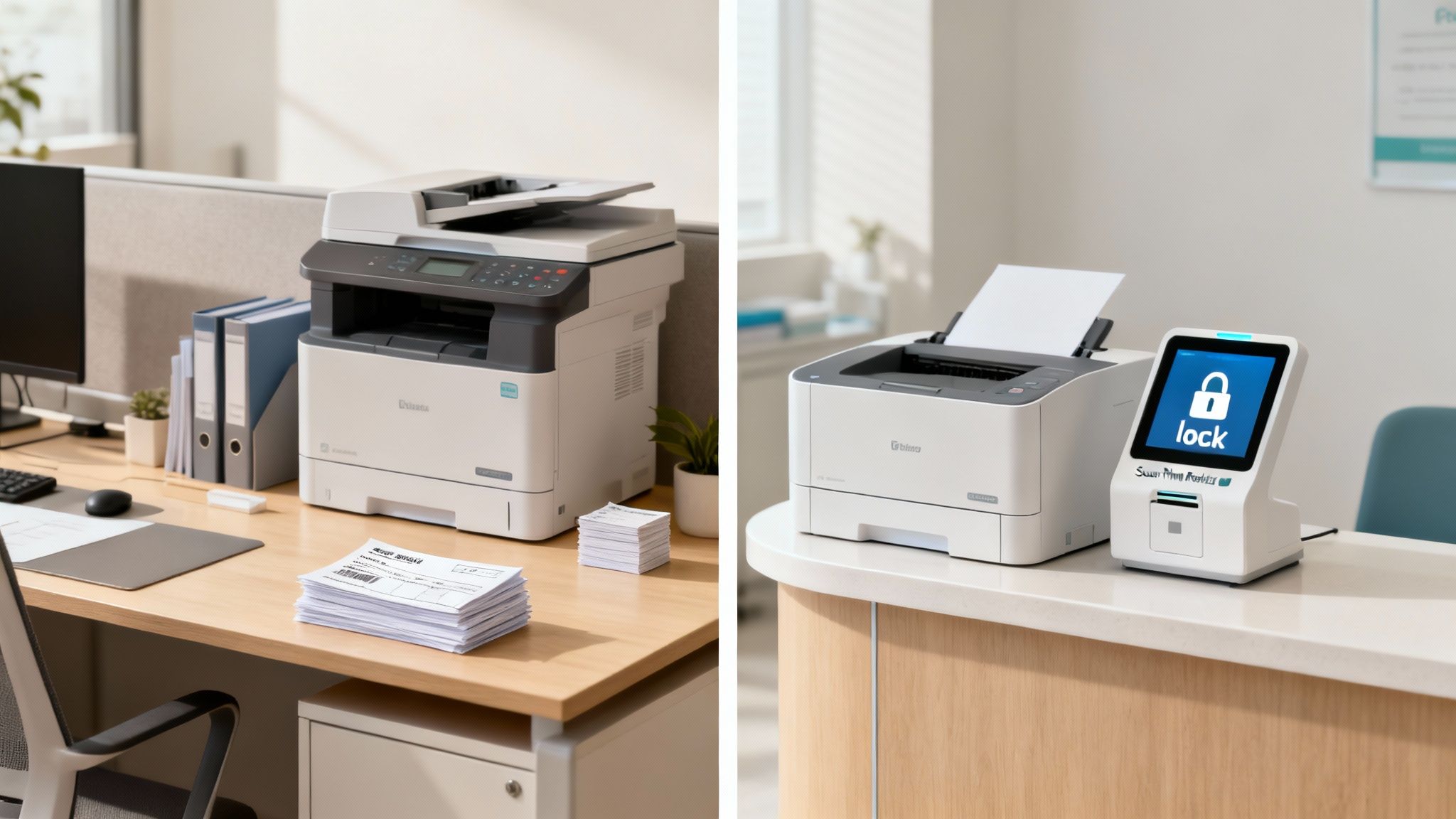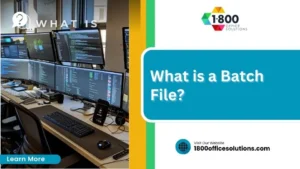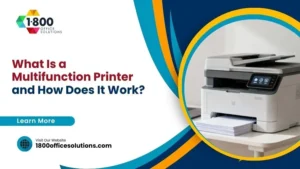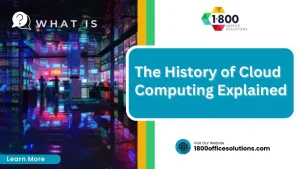What Is Managed Print Services? A Guide for Businesses
AI Overview:
Managed Print Services (MPS) streamlines and secures an organization’s entire print environment by outsourcing device management, supplies, maintenance, and security to a single provider. Through proactive monitoring, automated toner replenishment, hardware optimization, and secure print release, MPS reduces downtime, cuts costs (often by up to 30%), and strengthens compliance.
By converting unpredictable printing expenses into a controlled monthly plan, MPS improves productivity, supports sustainability goals, and frees IT teams to focus on higher-value work.
Uncontrolled printing costs, constant device errors, and potential security risks can drain company resources and distract your IT team from strategic projects. Managed Print Services (MPS) offers a comprehensive solution by placing your entire printing environment—printers, copiers, and scanners—under the expert management of a third-party provider. The primary purpose is to streamline operations, reduce expenses, and strengthen data security, turning a chaotic cost center into a strategic business asset.
This guide explains what managed print services are, how they work, and the tangible benefits they deliver to businesses of all sizes.
What Are Managed Print Services? An Explanation
Many businesses operate with a decentralized and inefficient collection of printing devices. Over time, different departments purchase various machines, leading to a mix of brands, models, and supply requirements. This fragmented approach creates significant hidden costs, security vulnerabilities, and frequent disruptions that pull your IT team away from mission-critical initiatives.
Managed print services is a strategic partnership designed to solve these problems by providing a single, accountable point of contact for every aspect of your print infrastructure.
A Proactive Approach To Your Print Environment
The key difference between MPS and traditional printer management is the shift from a reactive to a proactive model. Instead of scrambling when a toner cartridge runs empty or a critical printer fails, an MPS provider manages your entire fleet preemptively. This is what separates a true managed service from a simple hardware lease.
Your provider takes a holistic view, optimizing every component of your document workflow. They don’t just fix problems as they arise; they implement systems to prevent them from occurring in the first place.
What’s Typically Included In An MPS Program?
A robust MPS solution consolidates all your printing needs into one predictable service plan, converting volatile capital expenditures into a stable, manageable operational cost.
This table provides a clear breakdown of the core components and the value they bring to your organization.
Managed Print Services At A Glance
| Core Component | Primary Business Benefit |
|---|---|
| Hardware Optimization | Reduces waste and ensures teams have the right tools for the job. |
| Automated Supply Management | Eliminates downtime from running out of toner or other supplies. |
| Proactive Maintenance | Fixes issues before they become major problems, ensuring uptime. |
| Enhanced Security | Protects sensitive data with features like secure print release. |
| Reporting & Analytics | Provides insights to identify more savings and efficiency gains. |
Ultimately, an effective managed print services program is about more than just printers—it’s about providing the peace of mind that a critical business function is handled by experts, freeing you to focus on core growth activities.
The Building Blocks of an MPS Solution
A comprehensive managed print services program is not an off-the-shelf product. It is a tailored service that combines specialized components to create a seamless, secure, and cost-effective print environment.
Each element of an MPS solution is designed to address a specific business challenge, from uncontrolled costs to frequent device downtime. By bundling these services, a provider transforms a chaotic mix of machines into a genuine business asset.
Hardware Optimization and Fleet Management
The process begins with a thorough assessment of your existing printers and copiers. An MPS provider analyzes your actual business needs to design an optimized fleet. This often involves consolidating underused desktop printers into more powerful multifunction devices that handle printing, copying, scanning, and faxing from a central location.
This strategic consolidation is a cornerstone of MPS. The goal is to place the right device in the right location for the right tasks, eliminating workflow bottlenecks and reducing the total number of machines your IT team must support. This strategic placement directly improves employee productivity and cuts down on unnecessary hardware spending.
Proactive Supply and Maintenance Automation
One of the most immediate benefits is the end of frantic, last-minute toner orders. MPS solutions use remote monitoring software to track supply levels in real-time.
Instead of an employee manually checking cartridges, the system automatically triggers a shipment of new toner or other supplies. They arrive precisely when needed, well before you run out. This proactive approach eliminates downtime and prevents costly emergency purchases.
The same intelligent monitoring tracks device health. The software can detect potential issues—like a worn roller or a failing fuser—and dispatch a technician before a breakdown occurs. This predictive maintenance keeps your devices online and your teams productive.
Document and Workflow Integration
Modern MPS extends beyond paper. A key component is integrating your printers and copiers with your digital workflows. This can include setting up “scan-to-cloud” or “scan-to-email” functions that digitize paper documents and send them directly into your business applications or cloud storage platforms.
This integration bridges the gap between your physical and digital worlds, helping to automate manual processes and make information more accessible to your team.
Enhanced Security and Compliance Protocols
Finally, a quality MPS solution strengthens your entire print environment with multiple layers of security. These features go beyond basic network protection to safeguard the documents themselves.
- Secure Print Release: This critical feature holds a print job until the user authenticates at the device with a PIN or ID card. It prevents sensitive documents from being left unattended in the output tray.
- User Authentication: This function controls access to specific device features, ensuring only authorized personnel can perform actions like color printing or scanning to external drives.
- Device Hardening: Technicians configure printers and copiers to close security loopholes by disabling unused ports, updating firmware, and enforcing encrypted data transmission.
This strong focus on security is a primary driver for MPS adoption. The United States is the largest market for managed print services, accounting for 77.2% of the North American market in 2023. This growth is fueled by the continuous need for U.S. businesses to improve efficiency, control costs, and secure their data. You can explore more research on the North American MPS market to understand what is driving its expansion.
Your MPS Journey: From Assessment to Optimization
Transitioning to a managed print service is a structured process, not an overnight switch. It is a carefully planned journey designed to overhaul your print environment for maximum impact with minimal disruption to daily operations. The entire process unfolds over four distinct phases, guiding your organization from its current state to a fully optimized and managed infrastructure.
It begins with a deep analysis of your current setup.
The Critical Assessment Phase
Before any changes are made, an expert team conducts a thorough assessment of your current print environment. This audit goes beyond a simple device count to uncover hidden costs, security vulnerabilities, and workflow bottlenecks. This step identifies everything from underutilized desktop printers to departments with excessive printing costs.
A comprehensive evaluation forms the foundation of an effective MPS strategy. To fully understand the potential risks, it is valuable to learn what a professional print security assessment uncovers and why it is a crucial first step.
Designing Your Custom Solution
Using data from the assessment, the provider proceeds to the solution design phase. They develop a custom strategy that maps out the ideal print infrastructure for your specific business needs. This strategic plan determines the optimal number of devices, the best models for each department, and their placement to improve workflow efficiency.
This tailored approach ensures the new environment is built to address the pain points discovered during the assessment, guaranteeing a solution designed for peak efficiency and savings.
Implementation and a Smooth Transition
Next is the implementation phase, where the plan is put into action. This involves the professional installation and configuration of all new hardware and software. A key part of this stage is employee training to ensure your team can effectively use the new equipment and its features, leading to a smooth and productive transition.
This visual illustrates how the core pillars of an MPS solution—hardware, supplies, and security—are integrated throughout the process.

As shown, each step builds logically on the previous one, creating a unified and secure print ecosystem.
Ongoing Management and Optimization
Finally, the process transitions into a continuous cycle of ongoing management and optimization. Your provider will proactively monitor your fleet, automate toner and ink replenishment, and handle all maintenance. Regular performance reviews and data analysis help identify new opportunities for improvement, ensuring your print environment evolves with your business goals.
Part of this lifecycle management includes the responsible disposal of devices at their end-of-life. For more on this critical process, this guide on What Is IT Asset Disposition Explained offers valuable insights. This final component ensures your print strategy remains efficient, secure, and sustainable.
Tangible Business Benefits of Adopting MPS
Adopting a managed print service delivers measurable results that extend beyond device maintenance. It is a strategic business decision that positively impacts your bottom line, enhancing everything from cost control to team productivity. These benefits create a ripple effect across the organization, transforming an often-overlooked operational area into a center of efficiency and security.
The most immediate impact is a significant reduction in costs. Most businesses are unaware of their total print spending, which includes last-minute supply purchases, unexpected repair bills, and wasteful employee habits. An MPS provider identifies and eliminates these hidden expenses.
By consolidating devices, streamlining workflows, and reducing wasteful printing, businesses often achieve savings of up to 30% on their total print-related spending. This approach converts unpredictable capital outlays into a consistent, manageable monthly operational cost.
Strengthened Security and Compliance
In an age of frequent data breaches, an unsecured printer is a significant vulnerability. Managed print services provide the tools to secure your devices and protect sensitive documents. Features like secure print release—which requires user authentication at the device—ensure confidential information is never left exposed on an output tray.
Furthermore, your MPS provider enforces robust security protocols across your entire device fleet. This is not just a best practice; it is essential for meeting compliance standards like HIPAA or GDPR. Proactive security becomes an integral part of the service, not an expensive add-on.
Increased Productivity and Uptime
A “printer offline” error can bring critical projects to a standstill. MPS eliminates this frustration with proactive monitoring and predictive maintenance. Your provider monitors every device in real-time, identifying potential issues and scheduling service before a breakdown occurs.
This approach maximizes printer uptime, allowing your team to focus on their primary responsibilities instead of troubleshooting technical problems. It also frees your internal IT staff from the burden of print-related support tickets, enabling them to concentrate on strategic initiatives that drive business growth. The MPS market was valued at $27.5 billion in 2017 and is projected to reach $59.7 billion by 2025, reflecting its growing importance.
Promoting Corporate Sustainability Goals
Implementing an MPS partnership is an effective way to support your company’s environmental initiatives. By optimizing your printer fleet and establishing rules like default two-sided printing, you can significantly reduce paper and energy consumption. This creates a dual benefit: lowering operational costs while shrinking your company’s carbon footprint.
An effective MPS strategy can also help manage the production of physical marketing materials, such as direct mail services, ensuring all aspects of your print operations are as efficient as possible. To learn more about the financial benefits, explore our guide on managed print services cost reduction strategies.
Choosing the Right MPS Provider for Your Business
Selecting the right managed print services partner is a critical decision that will determine the success of your strategy. The best providers act as strategic allies, helping you align your print infrastructure with your broader business objectives. A proper evaluation requires a close look at their capabilities, service commitments, and technical expertise.
The foundation of a strong partnership is a clear and detailed Service Level Agreement (SLA). This document should explicitly define guaranteed response times for service calls, minimum device uptime percentages, and escalation procedures for unresolved issues. Vague terms in an SLA are a major red flag; you need concrete commitments to ensure printer downtime never disrupts your business.
Evaluating Technical Expertise and Partnerships
An MPS provider’s effectiveness depends on the technology they offer. Inquire about their partnerships with leading hardware and software manufacturers. A top-tier provider will have strong relationships with major brands, giving you access to reliable, best-in-class equipment that can scale with your business.
This technical expertise must extend to security and compliance. If you operate in a regulated industry like healthcare or finance, this is non-negotiable. Your provider must demonstrate a deep understanding of securing print devices, protecting sensitive data, and helping you maintain compliance with regulations like HIPAA or GDPR.
A provider’s role extends beyond fixing broken printers. They should serve as a security consultant for your entire document lifecycle, capable of implementing secure print release, user authentication, and data encryption across your fleet.
Data-Driven Insights and Reporting
The true value of an MPS partnership is revealed through data. A great provider will offer powerful reporting and analytics tools that provide a transparent view of your print environment. These reports should track key metrics like print volumes by user or department, device utilization rates, and your true cost-per-page.
This data-driven approach fosters continuous improvement. By analyzing these insights together, your provider can identify new opportunities to reduce costs, enhance workflows, and strengthen security over time. This transforms print management from a static expense into a dynamic, evolving business strategy.
To ensure a thorough evaluation, prepare a list of specific questions before engaging with potential vendors. These eight essential questions to ask an MPS provider offer a solid framework to guide your decision-making process and help you choose a partner with confidence.
Seeing MPS in Action Across Different Businesses
To fully appreciate the impact of managed print services, it is helpful to examine how they solve real-world business problems. The core principles of cost reduction, security enhancement, and efficiency improvement are adapted to meet the unique needs of each organization.

Here are two practical examples illustrating how an MPS provider can deliver transformative results.
Case Study: The Marketing Firm Drowning in Print Costs
A mid-sized marketing agency struggled with a chaotic mix of desktop printers. Their IT team was overwhelmed with support tickets for numerous models, and the accounting department could not accurately track toner invoices from various suppliers. Costs were unpredictable and steadily increasing.
An MPS provider implemented a solution tailored to their needs.
- Hardware Consolidation: All inefficient desktop printers were replaced with a few strategically placed multifunction devices designed for high-volume color printing.
- Predictable Budgeting: Hardware, supplies, and service were consolidated into a single, predictable monthly invoice, eliminating surprise expenses.
- Automated Supplies: With remote monitoring, new toner cartridges arrived automatically before the old ones were depleted. This change alone eliminated printer downtime and freed up hours for the IT team each week.
Case Study: The Healthcare Network Needing Ironclad Compliance
A regional healthcare network with multiple clinics faced a significant liability risk related to HIPAA compliance. They needed to provide staff with easy printer access without compromising the security of sensitive patient documents.
This challenge was primarily a security issue, not a cost problem. An MPS solution was implemented to secure the print environment. The key feature was secure print release, which required employees to swipe an ID badge at the printer to retrieve their documents.
This single change ensured that sensitive patient records were never left unattended in a print tray. The provider also supplied administrators with a centralized dashboard that provided a complete audit trail of every print, scan, and copy action, simplifying compliance reporting.
This global trend toward smarter, more secure printing is accelerating. The Asia-Pacific region is now the fastest-growing market for managed print services, with a projected CAGR of 12.1% through 2030, driven by small and mid-sized businesses seeking better control over print spending. You can discover more insights about the global MPS market to see the full scope of this expansion.
Frequently Asked Questions About MPS
If you are considering managed print services, you likely have questions. Here are clear answers to some of the most common inquiries from business leaders.
How Much Can My Business Realistically Save with MPS?
Most businesses achieve savings of up to 30%. The actual amount depends on your starting point, including your current print volume, the variety of devices in use, and existing workflow inefficiencies. A professional assessment from an MPS provider is the only way to obtain an accurate ROI calculation for your specific environment.
Is My Business Too Small for Managed Print Services?
Not at all. A common misconception is that MPS is exclusively for large corporations. These solutions are scalable and deliver significant benefits to small and medium-sized businesses (SMBs). Providers can create a custom plan that fits a smaller device fleet and budget, delivering the same core advantages: cost control, enhanced security, and streamlined operations.
What Is the Difference Between an MPS Contract and a Printer Lease?
This is a critical distinction. A printer lease is simply a financing agreement for hardware. An MPS contract, however, is a comprehensive service partnership.
An MPS partnership bundles everything into one solution: the hardware, all toner and supplies, proactive maintenance and repairs, remote monitoring, security management, and ongoing strategic guidance to continuously optimize your print environment.
Ready to transform your print infrastructure from a cost center into a strategic asset? The experts at 1-800 Office Solutions have over 40 years of experience designing MPS solutions that reduce costs and boost productivity for businesses nationwide. Get your free quote today and discover what a true managed print strategy can do for your organization.











